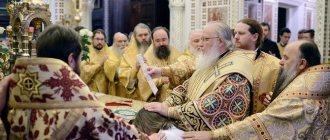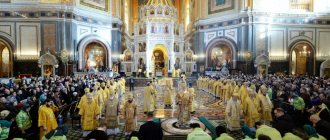Archpriest Andrei Ukhtomsky told the following story about himself:
“When I began to sexton, I came to the altar and greeted the priest sitting at a distance: “Hello!”
In response I heard: “Didn’t they teach you how to say hello?”
Having thought about what had been said, I went up to the priest and took the blessing, remembering how others had done it.
Now, already as a priest, during confession I have to hear the address “holy father” addressed to me.
And you yourself feel uncomfortable, trying to balance your unholiness with the attempt at politeness of the confessor, realizing that the saints are in heaven, thinking about how to convey to the confessor the options for correct treatment.
Andrey Ukhtomsky
archpriest
This is indeed a common difficulty among newly churchgoers. Dozens of questions on the forums: “how to contact the priest?”, “how to say goodbye?”
Well, let's find out.
Preface
Dear reader, first of all, in order to know how to address a clergyman correctly, you need to know their external differences.
We can say that it’s like military shoulder straps, which you just looked at and understood everything, found the words to address (Although, of course, someone in military uniform does not understand anything). Before you start reading this article, I recommend that you familiarize yourself with the previous material, “About Servants in the Temple,” which talks in detail about clergy and clergy.
Father is a polite informal address to a priest
What does the word "father" mean? This is an outdated, respectful and affectionate way to address your father. We can hear it in films about antiquity, read it in fairy tales or books of Russian classics.
In colloquial speech this word is practically not used in its original meaning, but in Orthodoxy traditions live longer, as evidenced by the many archaisms still used in religious contexts.
Where else today can you find such words as “child”, “right hand”, “eye”? Except in ironic meanings.
The tradition of calling priests fathers exists not only in Orthodoxy. In English-speaking countries they use "father", in Italy and Spain - "padre".
The official equivalent in Russia is “father” - with the obligatory addition of the name of the priest: “Father John”, “Father Thomas”, etc.
Saying simply “father” is not accepted according to church etiquette. Sounds too familiar.
Elder Ambrose of Optina is an outstanding Orthodox priest, an inspiring example for a believer
But “father” is a comprehensive and universal form. It is very convenient if, for example, the name of the priest is unknown to us.
Honest Father
another way to contact the priest
There is another option - “honest father”.
And yet why is the priest a father? There is no definite answer; it is lost in the past. The element of mentoring probably played a significant role.
Just as a parent teaches a child to live in the material world, so a spiritual father instructs him for spiritual life. Accordingly, the priest himself will not say about himself: “I am the father of such and such” - this is bad form.
Conversation with a priest
The importance of observing etiquette when communicating with clergy
When ordained to the priesthood, clergy are given special grace from God, and they are servants of God, even if, at first glance, the priest is too young, inexperienced, strict, or something else... Before God, this person is first and foremost a priest, a shepherd.
In this regard, a person who does not have a priestly order must have deep respect for the rank and the person who has accepted the priestly rank.
If you do not observe communication etiquette, then you blur the line between laity and clergy.
Let me emphasize an elementary thing: if you address a priest simply by name, you thereby erase this step between a person who has ordination and who does not, equating yourself with him in status, and the holy order is, of course, a special grace and a special burden. Therefore, in order to avoid basic mistakes, you need to know simple rules of etiquette. So, let's start from top to bottom.
Appeal to the Patriarch:
To the Patriarch: “Your Holiness.” A simpler address is “Holy Master” and nothing else (not “Holy Master” and not “Holy Master”).
Appeal to the Metropolitan or Archbishop
To metropolitans and archbishops: “Your Eminence”, “Most Reverend Vladyka”, the closest people can call “Vladyka”. It will be correct if, when addressing the metropolitan, a priest or parishioner makes a bow from the waist, touching the floor with his right hand, then straightening up, folding his hands, as in a blessing. And if the Lord put his hand on Vashi, you need to kiss it, if he put it on your head, then nothing else needs to be done.
Appeal to the Bishop
To bishops: “Your Eminence,” the greeting etiquette is the same as when communicating with metropolitans and archbishops.
Address to the priest
To priests: if a priest (archpriest, abbot or archimandrite) is aged and has awards, then it is customary to call him “Your Reverence,” if a priest (priest, hieromonk) is young, “Your Reverence.”
But it will not be offensive or a mistake to simply call the priest: “Father”, “Father_Name”, “Father”, “Honest Father” (a convenient address if you don’t know the name).
It would be a mistake to address the Orthodox priesthood as “Holy Father”; this is not the way to address the Orthodox priesthood.
When addressing a priest, it is not customary to bow from the waist. The person who is addressing simply folds his hands, as in a blessing, and if the priest puts his hand on yours, it is customary to kiss it, like a blessing hand. If you put it on your head, then nothing else needs to be done.
And, finally, the lowest hierarchy of the clergy is the deacon, who does not have the right to perform the sacraments, independently serve rites and perform services, but can only help in the service, because he does not have the grace-filled power that is given to the priests. Accordingly, the deacon cannot bless either. It is customary to address deacons and hierodeacons: “Your love for God,” to protodeacons and archdeacons “Your love for God,” “Father deacon,” “Father_name.”
It is not customary to call a deacon “Father” - this is considered a mistake.
It is customary to address the wives of clergy as mother.
Greetings of Orthodox Christians at a meeting
In pre-revolutionary times, when the Orthodox faith occupied a very important place in the life of Russian people, it was customary to enter the owner’s house with the words: “Peace to your home.” The response to this was “We accept in peace.” This greeting contains much more meaning than the current “hello”, “come on”, “see you”. However, certain features in greetings were developed over time in each individual region. Age and local customs played a role.
The rules of Orthodox etiquette are based on love and affirmation of faith in God
In past centuries, when people met, they said: “Christ is in our midst!”, to which they were answered: “He is and will be!” There was also “Peace be with you!”, with the answer “And to your spirit.” In general, the second option is one of the most ancient. This is how Jesus Christ himself and his apostles greeted people.
Many written materials have reached our time telling us how the laity greeted each other at the dawn of Christianity. By the way, priests always greeted in this way, accompanying the greeting with a three-time kiss on the cheek and a kiss on the right hand. Orthodox Christians say to each other: “Christ is risen!” on Easter days. And it is necessary to respond to these words: “Truly he is risen!”
Important! On holidays established by the church and on Sundays, the laity address their family and friends like this: “Happy Holidays!”
It was also customary among believers to kiss each other on the cheek. The men shook each other's hands firmly. Moscow custom involved kissing the cheek three times - men with men, women with women. In monastic circles, it is customary to kiss the shoulder. Some lay people have borrowed this too. Another custom has monastic roots. For example, when a person wants to enter someone’s room, he says: “Through the prayers of our Holy Fathers, Lord Jesus Christ our God, have mercy on us!” You can enter only after the room answers: “Amen.” This is hardly applicable for secular life, unlike monastic life.
In apostolic times, Christians greeted each other with a “holy kiss”
When meeting a priest, as a rule, they say: “Bless!” Ordinary people can also be greeted. The difference is that the priest responds to such an appeal: “God bless!”, and the layman must answer: “Bless!”
Those leaving home can be greeted with the words: “Your Guardian Angel!”, “God help you!”, “God bless you!”. Orthodox believe that this way you can protect a loved one from adversity along the way.
To address a stranger, in the Orthodox community they say: “sister”, “sister”; married women are addressed as “mother”. Men are called “brother”, “brother”, “father”. You can use the address “madam”, “master”, although in the conditions of current society they cannot always correctly interpret the meaning of these words.
For the service or help provided, our great-grandfathers said: “God save!”, “Christ save!”. Unchurched people will most likely be surprised, so you can simply answer them “Thank you!” This way, everyone can demonstrate that they appreciate what has been done for them.
Nuances!
It is not customary for lay men to shake hands with priests; it is correct to fold your hands for blessing, the priest will bless you and shake your hands, then it is customary to kiss the blessing hand.
Names must be pronounced as they sound in Church Slavonic; some names have a peculiarity in pronunciation: Not Sergei, but Sergius. Not Ivan, but John, not Alexey, but Alexy (emphasis on the last syllable).
If you approach the priests standing next to you, then it is customary to take the blessing in order of seniority from eldest to youngest. If it is not possible to take a blessing from everyone due to current circumstances, you can simply say: “Bless, Honest Fathers.”
The clergyman himself should introduce himself in this way: “Hello, my name is Priest Nikolai,” or, if the rank allows, “Archpriest Nikolai.”
One should not introduce oneself: “Father Nikolai” - this is neither decorous nor modest.
But despite how the priest introduced himself to you, it is customary to address the priest exactly as described above.
Orthodox etiquette
The basic rules of Orthodox etiquette are based on love and affirmation of faith in God. Here are the main ones:
Dear brothers and sisters! We invite you to visit the unique resource https://www.slovo-pomoshi.ru/. With its help, you can convey your aspirations to St. Petersburg churches, chapels, monasteries, and also contact the righteous at the place of their burial. We will write a note ourselves, take it to the temple and send you a photo report by email. Turning to God with the help of prayers has helped many people overcome grief, regain health and the joy of worldly life.
Useful articles:
The other day I consecrated an apartment in one house... I saw that the owners were well prepared: icons, cross stickers, candles, incense, oil... Stop. I look: there is some kind of red sediment and suspension in the oil. At first I even thought that this was oil from Unction. I'm starting to find out. They explain to me that, AS SUPPOSED (!), Tabasco sauce is added there!... Read more
He won't drink anymore. One young man became completely drunk and stole everything from the house. The wife could not stand such a life and left with the child. His friend found out that an old monk lives in Vyritsa who treats alcoholics, and began to persuade him to go: maybe the elder will help him be healed. He refused for a long time... Read more
“10 interesting facts about St. Spyridon” On October 30, the Greek delegation of the Orthodox Church brought to Kyiv a gift to Orthodox Christians - an icon of St. Spyridon of Trimifunt and a shoe from the holy relics of the saint. Let us present interesting facts about Saint Spyridon of Trimythous.1. Reverend all his life... Read more
Parable. When the Lord commands... A poor woman from a small family was very religious. And one day, when there was not enough money even to feed the children, she called the radio station and left there an appeal to God for help. While the radio employees treated the believing woman with understanding... Read more
Every morning of a believer should begin with a prayer request. Moreover, it also needs to be read at the beginning and end of any business. It is this that determines the attitude of a particular person towards loved ones and family. Saying “Lord bless” is a good habit that will provide protection from evil thoughts and bad deeds. If you come to visit, then according to the etiquette of a believer, you must say: “Peace to your home,” in answer, the owners of the house answer, “We accept you in peace.” And when everyone sits down at the dining guest table, they always wish each other “An Angel at the meal.” When meeting by chance on the street, it is customary to greet your neighbor with the words “Christ is in our midst,” and in response they answer, “And there is and will".
Such simple greetings help every person strengthen his faith and live with God in his heart.
The Lord is always with you!
Hierarchy of ecclesiastical orders
The hierarchical structure determines the strict order of addressing representatives of different levels of the clergy. Thanks to her, the church institution has been working clearly and smoothly for many centuries. According to generally accepted canons, all clergy are divided into three classes:
- Diaconate. The lowest level of the hierarchy, uniting protodeacons, deacons, hierodeacons, and archdeacons. These people are at the beginning of their careers, cannot perform the Sacraments and so far serve only as assistants to the highest dignitaries.
- Priesthood. The so-called middle class, which includes priests, hieromonks, archpriests, abbots, protopresbyters, archimandrites. Priests have the right to perform divine services and other services.
- Episcopate. The highest ranks, which include archbishops, bishops, patriarchs and metropolitans. This caste stands at the very top of the hierarchical system, heading the diocese.
Deacon
Priesthood
Bishop
The difference between a deacon and a priest is the presence of a pectoral cross
The priest must wear a pectoral cross and you can address him as “father.” It is
quite simple to distinguish a deacon from a priest: the deacon does not have a pectoral cross. The archimandrite wears a cross with decorations, the archpriest (abbot) wears a gilded or decorated cross, the priest (hieromonk) wears a silver cross.
In order not to be mistaken, you can use the simplest address: Father (name), and if you know the position, then (rector, vicar, dean): Father rector, father deacon, etc.
Sometimes getting a hint on the question of how to greet a priest (a person of clergy) will help you get acquainted. The clergy themselves, when introducing themselves, state their rank and name: Archpriest Vasily, Archdeacon Nikolai, and so on.
The rules for oral communications also apply to written ones.
These rules must also be followed in written requests. Official letters are written on a special form, informal letters are written on plain paper or on a letterhead with the name and position of the sender printed in the upper left corner (the reverse side of the sheet is usually not used). It is not customary for the Patriarch to send a letter on letterhead.
When writing to the hierarchs of the Local Orthodox Churches, the title of the Primate of the Church (Patriarch, Metropolitan or Archbishop) is always written with a capital letter. The title of the First Hierarch of the Autonomous Church is written in the same way. If the First Hierarch bears the double (triple) title of Patriarch and Metropolitan (Archbishop), then all these titles are also written with a capital letter: His Beatitude Philaret; Archbishop of Minsk.
Clergy of lower ranks are addressed briefly: His Most Reverend Archpriest (or Priest) (name, surname, position); in this case, the surname of the monastic person, if indicated, is always given in parentheses.
In accordance with accepted rules, a letter consists of: indication of the addressee, address (address-title), text itself, compliment, signature and date. In an official letter, the addressee includes the person's full title and position, in the dative case, for example, “To His Eminence, Most Reverend (name), Archbishop (name of the department), Chairman (name of the Synodal Department, commission, etc.).”
An address or address-title is an honorary title of the addressee. They start a letter with it and use it in the text. “Your Holiness” (in a letter to the Patriarch), “Your Majesty” (in a letter to the monarch), “Your Excellency,” etc. A compliment is an expression of politeness with which a letter ends.
An example of a compliment: “I ask for your prayers. I abide with true reverence and love for the Lord.” The author's personal signature is accompanied by a printed transcript. The date the letter was sent includes the day, month and year, and in official letters the outgoing number is also indicated.
Every believer considers it obligatory to ask for blessings when meeting with the priest.
How do parishioners communicate with the priest?
Communication with a priest can take place in different forms. Firstly, there is prayer (liturgical) communication. When the priest conducts the service and we are all present, there is a joint prayerful communication. Many prayers are sung not only in the choir, but also by everyone who is in the temple. For example, Our Father, Creed, Praise the name of the Lord..., Most honorable cherub... and others. Such communication is the highest prayer, and believers better feel the response of the fact that they visited the temple and worship.
Secondly, there is communication with the priest in the temple. It can be described as pedagogical. The priest teaches about something, says something, for example, reads sermons. Any Christian present in the church can hear in them answers to pressing questions. Fellowship also takes place in Sunday school. Here it is realized to a greater extent as a dialogue than a monologue. A Christian can ask questions directly to the priest and receive answers.
Personal communication with a priest
There is general communication, such as preaching, and there is private communication. A parishioner can approach the priest in private and ask his question. There are personal problems that cannot be announced publicly. But a Christian has a desire and a need to know what to do. For example, a girl just got married and doesn’t know what to do correctly in a given situation. She hasn’t read anything about it or has no one to tell her.
Many try to resolve their problems in confession, asking questions about something not related to repentance. It is not right. Confession is the result of the spiritual work done. Questions like “is it a sin or not a sin”, “can one do this or not” and so on are inappropriate here. You need to come to confession clearly knowing the answers to all these questions, and bring repentance and condemnation of yourself. All everyday moments and bewilderment should be removed so that the sacrament does not become darkened or dissipated.







